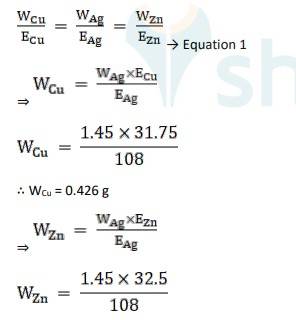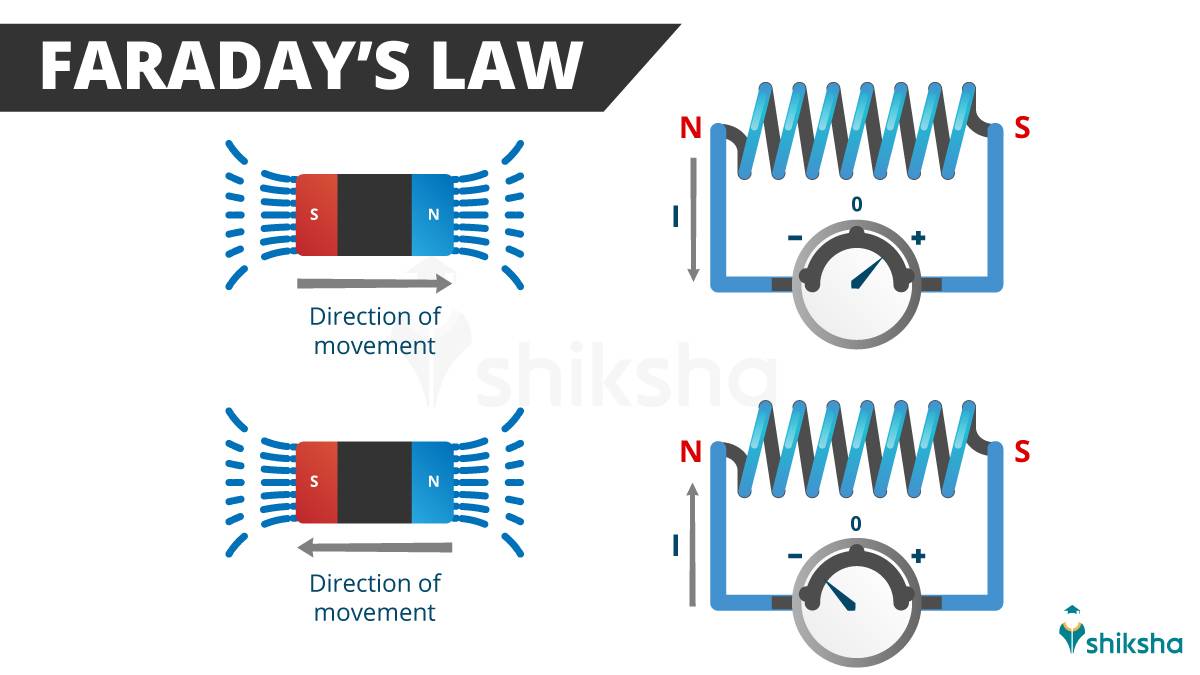
Faraday's Law is one of the important concepts in electromagnetism. This law helps to understand the relationship between electricity and magnetism. To understand this law in detail, we have to know about electromagnetic induction.
Various innovations, including modern generators, transformers, and other electronic items, are based on Faraday's Law. This law is taught in CBSE Class 12 Physics Chapter 6 Electromagnetic Induction. In this chapter, students are taught about the experiments of Faraday and Henry, magnetic flux, Faraday’s Law of induction, Lenz’s law and conservation of energy, motional electromotive force, inductance, and AC Generator.
Students must focus on the chapter to secure good marks in the board exam. To prepare for the text, students can use the NCERT Solution Class 12 Physics Chapter 6. Also, Faraday's Law is an important topic for the JEE Main exam.
- Faraday's First Law of Electromagnetic Induction
- Faraday's Second Law of Electromagnetic Induction
- What is Lenz’s Law
- Faraday’s Law Derivation
- Faraday's Law: Applications
- FAQs on Faraday's Law
Faraday's First Law of Electromagnetic Induction
According to Faraday's Law, if there is any change in the magnetic field of a closed loop wire, it will produce an electromotive force (EMF) in the wire. The working principle of a generator is based on Faraday's law.
Also Check:
| NCERT Class 12 notes | |
| Class 12 Maths NCERT Notes |
Faraday's Second Law of Electromagnetic Induction
Faraday's second law of electromagnetic induction is important to know the relationship between "rate of change of magnetic flux and induced EMF". According to this law, the magnitude of the induced EMF is directly proportional to the rate of change of magnetic flux.
The formula for Faraday's Law is:
Here,
- EMF stands for electromotive force (voltage),
- denotes the rate of change of magnetic flux, and
- The negative sign or minus sign (-) indicates that the induced EMF produces a current that opposes the change in magnetic flux ( Lenz's Law).
Faraday's second law of electromagnetic induction helps us to know how transformers, electric generators and other electromagnetic devices work.
Important Topics:
| NCERT Class 11 notes | |
| NCERT Class 11 Chemistry notes |
What is Lenz’s Law
Lenz's Law tells the direction of the induced current in a conductor. According to Lenz's law, the direction of the induced current is such that it always opposes the change in the magnetic field.
Lenz's law formula is given by
Emf = -N(Δφ/Δt)
Emf is the induced voltage (also known as electromotive force).
N is the number of loops.
Δφ is the change in magnetic flux
Δt is the change in time.
The negative sign shows that the direction of the induced emf and the change in the direction of the magnetic fields have opposite signs.
Faraday’s Law Derivation
Consider an experiment in which a magnet approaches a coil. Let T1 and T2 be the two time instances.
Flux linkage with the coil at the time T1 = NΦ1.
Flux linkage with the coil at the time T2 = NΦ2
Change in the flux linkage = N(Φ2 – Φ1)
Let the change in flux linkage is Φ = Φ2 – Φ1
Therefore, the change in flux linkage = NΦ
The rate of change of flux linkage = NΦ/t
Taking the derivative we get
N dΦ/dt
From Faraday’s second law of electromagnetic induction, we know that the induced emf in a coil is equal to the rate of change of flux linkage.
Hence, E = N dΦ/dt
Considering Lenz's law, E = - N dΦ/dt
We can conclude that when the number of turns in the coil increases, the induced emf increases.
When the magnetic field strength increases, the induced emf increases.
Increasing the speed of the relative motion between the coil and the magnet leads to an increased emf
Faraday's Law: Applications
- Transformers work on the principle of electromagnetic induction
- An induction motor is an application of Faraday's law
- An induction furnace is used in the kitchen
- An electrical generators work on the principle of electromagnetic induction.
- Tape recorders also work on the principle of electromagnetic induction.
FAQs on Faraday's Law
Q: How much charge is required for the following reductions: (i) 1 mol of Al3+ to Al? (ii) 1 mol of Cu2+ to Cu? (iii) 1 mol of MnO4 – to Mn2+ ?
A: The electrode reaction is given as,
Al3+ (aq) + 3e- → Al(s)
∴ The quantity of charge required for the reduction of 1 mol of Al3+ = 3F
= 3×96487 C
= 289461 C
The electrode reaction is given as,
Cu2+ (aq) + 2e- → Cu(s)
∴ The quantity of charge required for the reduction of 1 mol of Cu2+ = 2F
= 2×96487 C
= 192974 C
The electrode reaction is given as, MnO4→ Mn2+
i.e., Mn7+ + 5e - → Mn2+
∴ The quantity of charge required for the reduction of 1 mol of Mn7+ = 5F
= 5×96487 C
= 482435 C
Q: How much electricity in terms of Faraday is required to produce (i) 20.0 g of Ca from molten CaCl2?
A: (i) Ca2+ + 2e- → Ca
⇒ Here, 1 mole of Ca, i.e., 40g of Ca requires = 2 F electricity (F if Faraday)
∴ 20g of Ca requires = 20X2/40
= 1 F of electricity
Electricity in terms of Faraday required to produce 20.0 g of Ca from molten CaCl2 is 1 F of electricity.
(ii) Al3+ + 3e- → Al
⇒ 1 mole of Al, i.e., 27g of Al requires = 3 F electricity (F if Faraday)
∴ 40.0 g of Al will require = 3/27 X 40
= 4.44 F of electricity
Electricity in terms of Faraday required to produce 40.0 g of Al from molten Al2O3 is 4.44 F of electricity.
Q: How much electricity is required in coulomb for the oxidation of (i) 1 mol of H2O to O2 ? (ii) 1 mol of FeO to Fe2 O3 ?
A: The electrode reaction for 1 mole of H2O is given as,
H2O → H2 + 1/2O2
i.e., O2- →1/2 O2 + 2e -
∴ The quantity of electricity required = 2F
= 2×96487 C
= 192974 C
The quantity of electricity required in coulomb for the oxidation of 1 mol of H2O to O2 is 192974 C
- (ii) The electrode reaction for 1 mole of FeO is
FeO + 1/2 O2 → 1/2 Fe2O3
i.e., Fe2+ → Fe3+ + e -
∴ The quantity of electricity required = 1F
= 1×96487 C
= 96487 C
The quantity of electricity required in coulomb for the oxidation of 1 mol of FeO to Fe2O3 is 96487 C
Q: A solution of Ni(NO3)2 is electrolysed between platinum electrodes using a current of 5 amperes for 20 minutes. What mass of Ni is deposited at the cathode?
A: Quantity of electricity passed = 5 A × (20 × 60 sec)
= 6000 C ⇒ Equation 1
The electrode reaction is written as,
Ni2+ + 2e → Ni
Thus, the quantity of electricity required = 2F
= 2×96487 C
= 192974 C
∵ 192974 C of electricity deposits 1 mole of Ni, which is 58.7 g ⇒ Equation 2
Thus, equating equations 1 and 2, we get
192974 C of electricity deposits = 58.7 g
6000 C of electricity will deposit = 58.7 X 6000 / 192974
= 1.825g of Ni
The mass of Ni deposited at the cathode is 1.825g of Ni
Q: Three electrolytic cells A, B, C containing solutions of ZnSO4 , AgNO3 and CuSO4 , respectively are connected in series. A steady current of 1.5 amperes was passed through them until 1.45 g of silver deposited at the cathode of cell B. How long did the current flow? What mass of copper and zinc were deposited?
A: Equivalent weight is Ag, EAg = 180/1 = 180
Equivalent weight is Cu, ECu = 63.5 / 2 = 31.75
Equivalent weight is Zn, EZn= 65/2 = 32.5
Using Faraday’s second law of electrolysis, to find the mass of Cu and Zn, we use Equation 1,

∴ WZn = 0.436 g
To find the time of current flow, using Faraday’s first law of electrolysis we get,
M = Z ×I ×t ⇒ Equation 2
∵ Z = Equivalent Weight / 96487 , Equation 2 becomes,
M = 108 / 96487 X 1.5 X t
t = 1.45 X 96487 / 108X 1.5
t = 864 seconds.
The time of current flow, t = 864 seconds, the mass of Cu is 0.426 g and mass of Zn is 0.436 g
Chemistry Atoms and Molecules Exam
Student Forum
Popular Courses After 12th
Exams accepted
CA FoundationExams accepted
ICSI ExamExams accepted
BHU UET | GLAET | GD Goenka TestBachelor of Business Administration & Bachelor of Law
Exams accepted
CLAT | LSAT India | AIBEExams accepted
IPMAT | NMIMS - NPAT | SET
Exams accepted
BHU UET | KUK Entrance Exam | JMI Entrance ExamBachelor of Design in Animation (BDes)
Exams accepted
UCEED | NIFT Entrance Exam | NID Entrance ExamBA LLB (Bachelor of Arts + Bachelor of Laws)
Exams accepted
CLAT | AILET | LSAT IndiaBachelor of Journalism & Mass Communication (BJMC)
Exams accepted
LUACMAT | SRMHCAT | GD Goenka Test

